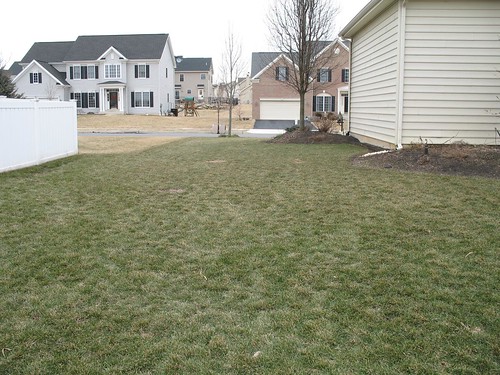I'd tentatively say it doesn't look too bad for December first...
The standard shot. As always, click to embiggen, and you can click again on the larger version for a super-sized one.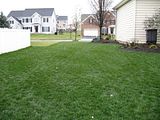
Here's the front lawn, with a few leaves down in the latest wind storm today. I thought the contrast down the block was amusing. When driving up the street, there's one dark green patch...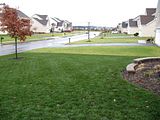
Wednesday, December 1, 2010
December Photos
Sunday, November 28, 2010
Yearly Garden Additions
This is for the gardens, which received about 560 pounds of organics (not including mulch), or about 280 per thousand square feet.
| Date | N | P | K | Iron | Organics | Other Notes |
| 3/18/2010 | 2.25 | 0.90 | 0.00 | 1.80 | 45.0 | Milorganite |
| 3/28/2010 | 1.80 | 0.72 | 0.00 | 1.44 | 36.0 | Milorganite |
| 4/7/2010 | 3.40 | 2.88 | 0.40 | 1.44 | 36.0 | Milorganite, Starter |
| 4/11/2010 | 1.75 | 0.25 | 0.50 | 0.00 | 25.0 | Soybean Meal |
| 5/6/2010 | 2.50 | 1.42 | 0.70 | 1.44 | 36.0 | 10-10-10, Milorganite |
| 6/3/2010 | 2.95 | 1.77 | 1.02 | 0.00 | 25.0 | 10-10-10, Starter, Soy |
| 7/1/2010 | 2.25 | 0.93 | 0.63 | 0.00 | 25.0 | Starter, Soybean Meal |
| 8/1/2010 | 1.05 | 0.90 | 0.13 | 0.44 | 11.0 | Starter, Milorganite |
| 9/1/2010 | 1.75 | 0.25 | 0.50 | 0.00 | 25.0 | Soybean Meal |
| 10/2/2010 | 0.90 | 0.36 | 0.00 | 0.72 | 18.0 | Milorganite |
| Total per K ft: | 20.60 | 10.36 | 3.88 | 7.28 | 282.0 | 564 active organic total |
Yearly Lawn Additions
As of today, the year is done. The Winterizer went down this afternoon!
Here's the chart of all additions on the lawn throughout the entire gardening season. It sums to about 2,880 pounds total material, or about 450 pounds per thousand square feet. I'll publish the gardens separately.
| Date | N | P | K | Iron | Organics | Other Notes |
| 3/7/2010 | 0.64 | 0.26 | 0.00 | 0.51 | 12.8 | Milorganite |
| 4/1/2010 | 0.77 | 0.31 | 0.00 | 0.75 | 15.4 | Milorganite, FeSO4 |
| 4/11/2010 | 0.35 | 0.14 | 0.09 | 0.00 | 21.4 | Cracked Corn |
| 4/25/2010 | 1.16 | 0.17 | 0.33 | 0.00 | 16.7 | Soybean Meal |
| 5/7/2010 | 0.60 | 0.81 | 0.15 | 3.57 | 0.00 | Starter Fertilizer, FeSO4 |
| 5/21/2010 | 1.01 | 0.28 | 0.14 | 0.41 | 17.4 | Soybean Meal, Milorganite |
| 6/15/2010 | 1.01 | 0.28 | 0.14 | 0.41 | 17.4 | Soybean Meal, Milorganite |
| 7/8/2010 | 1.01 | 0.28 | 0.14 | 0.41 | 17.4 | Soybean Meal, Milorganite |
| 7/20/2010 | 0.00 | 0.00 | 0.00 | 3.57 | 0.00 | FeSO4 |
| 8/1/2010 | 1.11 | 0.39 | 0.06 | 0.73 | 21.0 | Milorganite, Soybean Meal |
| 8/15/2010 | 1.26 | 0.24 | 0.29 | 0.21 | 19.4 | Soybean Meal, Milorganite |
| 8/29/2010 | 1.77 | 0.44 | 0.29 | 0.62 | 29.7 | Milorganite, Soybean Meal |
| 9/12/2010 | 1.00 | 0.14 | 0.29 | 0.00 | 14.3 | Soybean Meal |
| 9/19/2010 | 1.16 | 0.00 | 0.16 | 0.00 | 0.00 | Vigoro 29-0-4 |
| 9/26/2010 | 1.00 | 0.14 | 0.29 | 0.00 | 14.3 | Soybean Meal |
| 10/3/2010 | 0.96 | 0.39 | 0.00 | 0.77 | 19.3 | Milorganite |
| 10/11/2010 | 0.83 | 0.00 | 0.11 | 0.00 | 0.00 | Vigoro 29-0-4 |
| 10/17/2010 | 0.90 | 0.36 | 0.00 | 0.72 | 18.0 | Milorganite |
| 11/15/2010 | 1.55 | 0.68 | 0.29 | 0.00 | 194.2 | Leaves |
| 11/28/2010 | 1.50 | 0.00 | 0.21 | 0.21 | 0.00 | Vigoro Super Green |
| Total per K ft: | 19.59 | 5.31 | 2.98 | 12.89 | 448.7 | 2879 active organic total |
Monday, November 15, 2010
More Leaves
I've finished the leaves through most of the lawn, leaving only about a hundred square feet so I have a place to mulch the garden waste for composting. It's likely I'll get a few more bags. Some will be composted, plus I'll add some to the problem areas in the lawn to help retain water next year.
The total so far is 1,050 pounds in 91.5 bags. I skipped the swale, so that's a grand total of 175 pounds per thousand, or about 1.4 pounds nitrogen, 0.61 pounds phosphorus, and 0.26 pounds potassium. Plus small amounts of every other element.
The organic total for the lawn so far this year is 429.5 pounds per thousand, or 2,814 pounds over the entire lawn. I'm probably done with the organics, but won't post the charts for the year until winterization is complete, probably in a week or two or three, depending on our weather.
Saturday, November 6, 2010
Leaf Score!
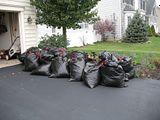
Click on the above for a larger version.
Today's leaf score was 27.5 bags, mowed small and packed down solidly. Figure that's close to 350 pounds of leaves--estimating low, which I always do. That should be sufficient to cover about 2,000 square feet of lawn.
I'm shooting for around 150 pounds per thousand square feet total this year, or about a thousand pounds of leaves. Some areas will receive around 300 pounds per thousand, most notably those where I had drought damage this summer. Those retain water less well than other areas at the moment.
So why am I mulching that many leaves? Click here to see why!
Monday, October 25, 2010
Ferrous Ammonium Sulfate
...and some basic chemistry.
Thanks to Gary in Chicago and some chemical calculations, the lawn has darkened considerably (even more than before):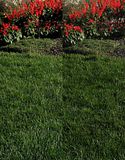
You can make your own ferrous ammonium sulfate very easily from two separate chemicals: ferrous sulfate and ammonium sulfate.
I have some rough measurements and calculations that work for me. The solution should be relatively close to equimolar (containing an equal number of moles of each chemical. A mole is around 6 × 1023 molecules, but as long as the molecule count is the same, it doesn't matter how many there actually are).
Fortunately you don't need a very powerful magnifying glass and the ability to count to extremely high numbers! A little basic chemistry will tell you that there are 151.91 grams of material in 1 mole of ferrous sulfate, 132.14 grams in a mole of ammonium sulfate. As long as you use 1.15 times as much ferrous sulfate by weight as you do ammonium sulfate, the solution will be close to pure ferrous ammonium sulfate.
It isn't that critical to be precise, so a 1 to 1 ratio is more than good enough. Ammonium sulfate can strip some calcium from plants, so tilting the balance toward the ferrous sulfate is best--use more than 1.15 times the weight of ferrous sulfate as ammonium sulfate.
One thing to note is that this is by weight. My ferrous sulfate doesn't seem to pack as well as the ammonium sulfate, so I require about twice as much by volume. Your mileage will almost certainly differ.
Two to four ounces per thousand square feet in three gallons of water worked best for me. Let it sit on the grass for 24 hours, then irrigate in well. This solution should never be applied if temperatures will be over 80 degrees F.
With a good eye, you may notice a slight color change in an hour (I did). However, if the lawn requires the iron, you'll certainly notice it within a day or two. Color durability is much better than plain ferrous sulfate--post the next mow, I still saw very dark green color that hasn't faded at all.
Wednesday, October 13, 2010
Photo Update
Lawn performance has improved since the rains resumed at the end of September. I caught these shots today just before the next rainstorm comes through tomorrow.
The bit of cheating with synthetics I did seemed to increase the lawn density but never caused excessive top growth.
The standard shot. As always, sorry for the slightly blurry thumbnail--you can click the image to enlarge it, and click again on the image on PhotoBucket's site to enlarge it even further!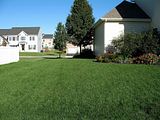
The gardens. Most of the marigolds have timed out and are gone for the season, but the salvia and celosia just keep going. The cannas aren't looking bad for October, either.
Bonus image! An October rose, with its friends in the background. This rosebush, a Double Knockout, usually blooms through November.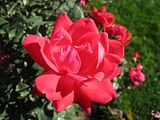
Sunday, September 19, 2010
Cheater!
The lawn is having some slight issues coming back from this summer's damage. Root growth has been excellent from what I can tell, but top growth is slow and spreading is very slow.
So I applied 4 pounds per thousand of 29-0-4 (4.8% of that is slow release nitrogen) today and I'm currently watering it in. It works out to just about exactly a pound of quickly available nitrogen per thousand square feet.
The weather is still a bit on the warm side for grasses, and very warm for late September. Our daily high today was 82°, with estimated highs ranging from 73° tomorrow to 83° on Wednesday. That's limiting the lawn's recovery, but we're also running out of time. While frost and freeze may be late, I don't think they'll be all that late.
I could be wrong about that. I hope I am.
I should see the initial impact from this application by Tuesday or Wednesday, with faster growth continuing for a number of weeks.
Thursday, September 16, 2010
Seed Starting
I'm putting together a seed-starting unit for next spring. Every year, I need about seven full flats of annuals in the gardens, and our local nurseries always have the same old things available. This will give me a lot more latitude on what I add, although some of the old favorites will still make an appearance.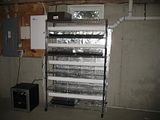
That's the unit, a standard shelf with open gridwork for air and light transmission between the levels. I hung a T12 work lamp on each level, with 2 40 watt bulbs in them. One warm white and one cool white should give a good enough spectrum for seed starting and initial growth. With minimal distance over the sprouts, I should have around 1,000 foot-candles. That's a bit low, but should be workable.
I put aluminum foil behind the unit for additional light reflection. Mylar would probably be better, but I had Reynolds Wrap on-hand!
I've been collecting seeds from the garden for storage. At the moment, I have Melampodium (Showstar), Bonfire salvia (although they probably reproduced with the Red Hot Sally), and French marigold seed (of random colors as I have a wide mix).
Germination testing on the Melampodium is going well. I suspect the others require a dormancy period before testing, so I'll try those in December or January, early enough to order seeds if they fail.
Wednesday, September 15, 2010
September Lawn/Garden Photos
The lawn came through the (very) hot summer pretty well, although there are some scorched areas that are recovering. The gardens seem to be about three weeks ahead of their normal point, so I've been progressively removing plants that are reaching the end of their lifespans. What remains looks fairly shaggy for September, but seed production has been quite good.
Oddly, some volunteer plants that normally wouldn't begin to sprout until next year have already begun in the garden. Those will die out at frost.
As always, you can click to embiggen any photograph. Once on the PhotoBucket site, clicking again will make it larger still.
Here's the standard shot. Color is fair to middling for September, but starting to improve as the season cools and rain comes a bit more often: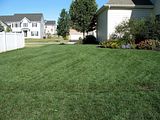
Again, I found this amusing. The property line is sharp and there's definitely no doubt of where it is. There's some slight dormancy in here, but that's reversing: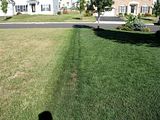
Here's a photo of the garden. You can see the marigolds are giving up fast, but the salvia and cannas are doing well: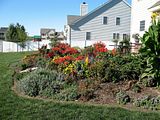
Bonus image! A nearly perfect aster (with a beetle of some sort noodling around in it):
Another bonus! An almost-perfect rose...no beetles on this one!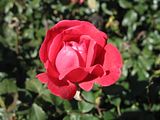
Sunday, August 29, 2010
Highest Feeding Point
The weather still says summer with highs of 94 degrees or better through the week (exceedingly odd for late August). However, the grass will begin consuming massive amounts of nitrogen in September, so the year's heaviest feeding went today.
I applied 14.3 pounds of soybean meal, plus 15.4 pounds of Milorganite per thousand square feet. That will supply 1.77 pounds of nitrogen, 0.44 pounds of phosphoric acid (equivalent), 0.29 pounds of potassium, and 0.62 pounds of iron.
The next feeding will be applied in two weeks, but that will be somewhat lighter.
Sunday, August 15, 2010
More Lawn Feeding
We have showers coming through today, so I ducked out between the raindrops and fed the lawn for the second time in August.
This time, I used 14.3 pounds per thousand square feet of soybean meal, and 5.1 pounds per thousand of Milorganite. That works out to a grand total of 1.26 pounds of nitrogen, 0.24 pounds of phosphorous, 0.29 pounds of potassium, and 0.21 pounds of iron per thousand square feet.
Technically, this feeding was completely unnecessary--it brings my August total to 2.37 pounds of organic nitrogen per thousand square feet. However, with the damage done to the lawn by the hot and dry summer, plus the fact that fall lawns are very hungry, this can only help it out.
The current grand total is 159 pounds of organics per thousand square feet, yielding 8.92 pounds of nitrogen. September's feeding will be similar, and I'll back off in October and November.
Saturday, July 24, 2010
Feeding Update
I've been pretty good about publishing photos, but I haven't been so good about updating how I'm keeping the lawn looking like that!
With my low iron levels (1.3 PPM on the last soil test), and slightly high pH, iron's critical. I've dropped 50 pounds of ferrous sulfate (7.1 pounds per thousand) this year to help with both iron levels and the pH. Ferrous sulfate has about 1/8th the acidifying power of elemental sulfur, so this is the equivalent of a bit under a pound of sulfur per thousand.
I've backed off on feeding this year what with the heat and the fact that the soil simply doesn't need it any longer. So far, 118 pounds per thousand square feet of organic feedings have gone down. I'm dividing that into half Milorganite, half soybean meal for most feedings, although I did drop 20 pounds per thousand square feet of cracked corn earlier in the season to help with any fungal issues.
All things considered, that works out (per thousand square feet so far this year) to 6.5 pounds of organic nitrogen, 2.5 pounds of phosphorus, 1 pound of potassium, and 9.6 pounds of iron.
August's feeding goes right around the first, and that will be pure Milorganite. The second August feeding will be soybean meal, around the 15th. That will help get the lawn fed for fall when it really wants the nitrogen. I'll continue heavily feeding in September as well since the weather is still compatible.
Monday, July 19, 2010
Drought Lawn/Garden Photos
We're in an irregular and extended drought in the area, but the lawn and gardens are still doing amazingly well. I haven't irrigated the lawn since the Fourth of July (although, of course, the gardens require water regularly).
If you click on the blurry (sorry about that; PhotoBucket doesn't do a good job with thumbs) image below, you can enlarge it. Clicking on that resulting larger image will show you an even larger one!
Here's the standard lawn shot: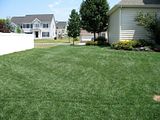
I found this amusing: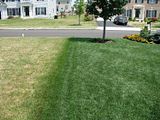
Here's a shot of the back garden:
And a bonus image--a new Gaillardia just sending its first bloom. There are plenty more where that came from.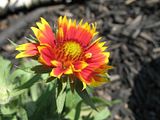
Friday, July 2, 2010
More Lawn & Garden Photos
I'll be letting the lawn go down for the summer around the fourth this year, it's too hot and dry to try to maintain it at any reasonable cost. So instead of waiting a few extra days, I took my photos today when the lawn is at its peak. The gardens will be maintained, of course!
As always, click on any shot to embiggen it. The larger versions aren't blurry...
Now, if you click on the PhotoBucket enlarged shot, it'll enlarge again. I changed over to uploading photos in the 1 Mb version.
The standard lawn shot:
Here's the southern face of the lawn, now with robot tracks all over it. I'd just finished mowing it.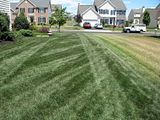
The front line damage hasn't repaired itself much, but the weather's been too hot and dry for spreading: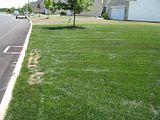
I've even had some losses in the gardens due to the weather, but fortunately I have Rocket snapdragons and celosia volunteering all over the place.
And here's a bonus closeup of the blossoming bee balm. I had to flip the bees off of it to get the shot.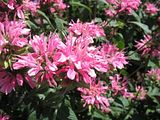
Thursday, June 17, 2010
Lawn and Garden Photos
Here's the standard lawn shot from today, June 17th (as always, click to embiggen):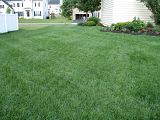
And here's the front lawn damage. It's closing fast!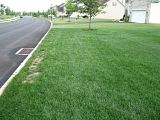
Here's an overall shot of the back gardens. I still have a bit of mess from the last thunderstorm:
Bonus shot! A blooming Asiatic lily: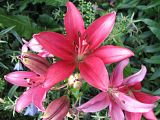
Thursday, May 13, 2010
Lawn Photos
I've updated my lawn photos (finally). This is just post-mowing, so you can see the robot's sort of random lines in the lawn. Color is good, but not quite perfect yet.
Click on any photo to see the larger version!
Here's my standard shot: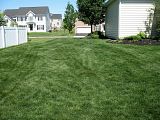
The front township damage from last year is finally closing off: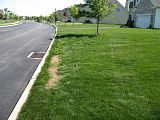
Here's a photo of the southern face and garden. The clematis looks pretty good, but I'm afraid the dogwood it's climbing up is a lost cause--it's probably Dogwood anthracnose fungus, which means the tree will die.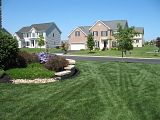
Wednesday, May 12, 2010
Frost Damage
Regrettably, I lost all the Melampodium (fortunately, I only had 8). Temperatures last night dropped to 31, and I barely managed to hold off a frost. Melampodium is extremely unhappy even at 35. I purchased replacements for those today when I ran out for this year's heliotrope.
It also looks like a dozen or so marigolds were frost-burned in the northeastern garden. I'll need to replace those as well when I can go get the Janie marigolds.
It's a shame, but at least I only lost 20 plants out of 850 or so, and they're easy and cheap to replace.
On the up side, it looks like we're clear of frost for at least a week, by which time a frost becomes extremely unlikely!
Sunday, May 9, 2010
Frost Warning!
Surprisingly, most of us in Pennsylvania and areas northward are under a frost or freeze warning for tonight.
If you have tender annuals in already (I do), watering the gardens before dark, including the surrounding areas, will help limit the temperature drop and keep the frost off the plants. See "A Veil of Frost Protection," about 3 posts down, for more information.
Update: That reference above was a tease, and I hate teasing. Here's a reprint of the same information:
There are a few ways to protect gardens from an unexpected frost.
The most common is to cover the plants, which is not realistic in my case–there are too many, and in areas that are too large. With all the burlap I have on-hand, I might be able to cover 1/3 of the garden that’s at risk. Additionally, it must be promptly removed in the morning or the plants may end up baking under the covering.
In my case, I ran the watering systems on the grass for twenty minutes and the garden for the same. Raising the humidity to nearly 100% at 45 degrees makes temperature drops difficult. The dew point is higher, so as temperatures try to drop the water has to condense out of the air, releasing a large amount of heat and helping to protect the plants. Additionally, the condensed water settles on the plants and soil at the temperature at which it condensed, helping to stop further drops in temperature.
The veil of frost protection woven by applying water is delicate and can be overcome if temperatures fall under 32°, but most unseasonable frosts can be overcome this way.
Wednesday, May 5, 2010
Sub-Zero Rose
[caption id="attachment_261" align="alignleft" width="151" caption="Margaret Chase Smith Sub-Zero rose"] [/caption]
[/caption]
I planted a new Margaret Chase Smith Sub-Zero rose to replace the Double Knockout rose I lost over the winter. As it turns out, the bud union (the swelling at the bottom of the stem) should be planted 1" underground for Zone 6 and 2" underground for colder locations. I planted the Double Knockout's bud union at ground level or slightly above, in an area with intense winter winds.
Tuesday, May 4, 2010
Milk On The Lawn
I applied 4 ounces per thousand of whole milk (pasteurized and homogenized) today to test whether it enhances the soil and lawn quality.
Done with raw milk (straight from the cow) it seems to work. This will see if processed milk from the grocery store (cheap and easily available) is also an option.
Wednesday, April 28, 2010
The Veil Worked
The recorded lows around me, generally within a degree of agreeing with my outside thermometer, reached 31 to 32 degrees.
My recorded low temperature in the garden was 39.6 degrees, more than warm enough for what's currently in.
I successfully maintained a temperature differential of around 8 degrees.
I'll be doing the same thing again tonight as the same low temperatures apply.
Monday, April 26, 2010
A Veil of Frost Protection
I started planting annuals late last week when the weather forecast showed we were clear of frost well into May. Naturally, we have a projected low of 35° and we're under a frost warning and freeze watch.
There are a few ways to protect gardens from an unexpected frost.
The most common is to cover the plants, which is not realistic in my case--there are too many, and in areas that are too large. With all the burlap I have on-hand, I might be able to cover 1/3 of the garden that's at risk. Additionally, it must be promptly removed in the morning or the plants may end up baking under the covering.
In my case, I ran the watering systems on the grass for twenty minutes and the garden for the same. Raising the humidity to nearly 100% at 45 degrees makes temperature drops difficult. The dew point is higher, so as temperatures try to drop the water has to condense out of the air, releasing a large amount of heat and helping to protect the plants. Additionally, the condensed water settles on the plants and soil at the temperature at which it condensed, helping to stop further drops in temperature.
The veil of frost protection woven by applying water is delicate and can be overcome if temperatures fall under 32°, but most unseasonable frosts can be overcome this way.
Wednesday, April 14, 2010
This Year's Prices
Cracked corn cost me $6.38 for 50 pounds this year, or down 6.5% from last year. Soy was $10.52 for 50 pounds, or down 4.1%.
Since last year's prices were fairly normal, I profess myself very pleased!
Sunday, April 11, 2010
P. Annua Repair
Gary requested that I post the complete series of P. annua repair shots in my lawn for reference. My results were not typical; this involved never letting the deep soil go completely dry, and feeding this area at three times my already heavy rate for 2008.
Looking back at my notes, I watered an average of every 3 to 5 days depending on the weather, and applied 450 pounds per thousand equivalent across the entire damaged area to speed repair. I used a mix of Milorganite, soybean meal, and one light dose of alfalfa in early August. I recorded the weather that summer as fairly hot and dry, so spreading was a bit slower than it would be during a more normal year.
[caption id="" align="alignnone" width="640" caption="May 7, 2008, just post dying"]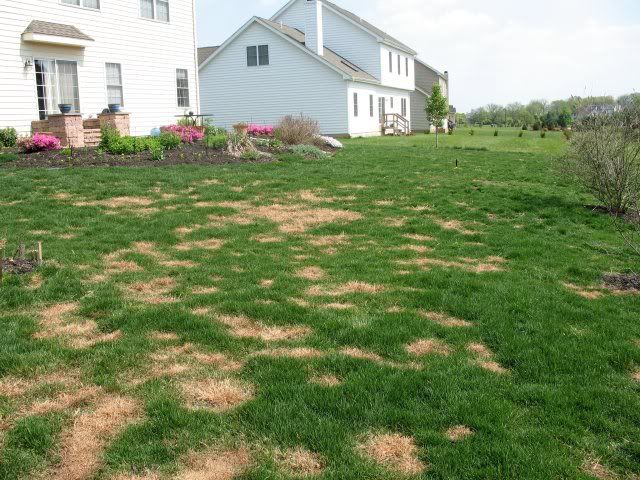 [/caption]
[/caption]
[caption id="" align="alignnone" width="640" caption="June 15, 2008, about 5 weeks"]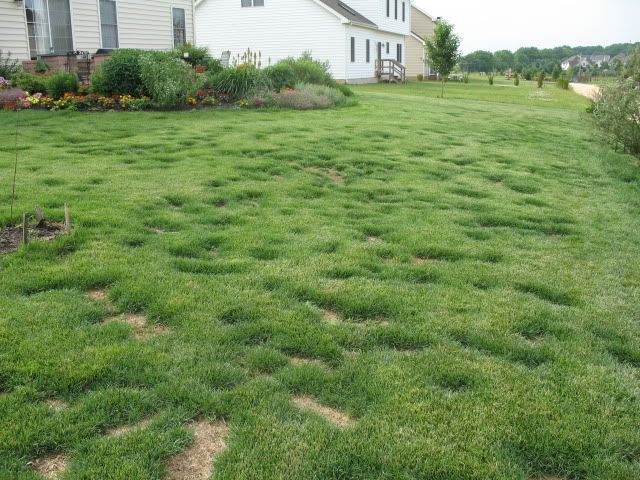 [/caption]
[/caption]
[caption id="" align="alignnone" width="640" caption="July 5, 2008, about 8 weeks"]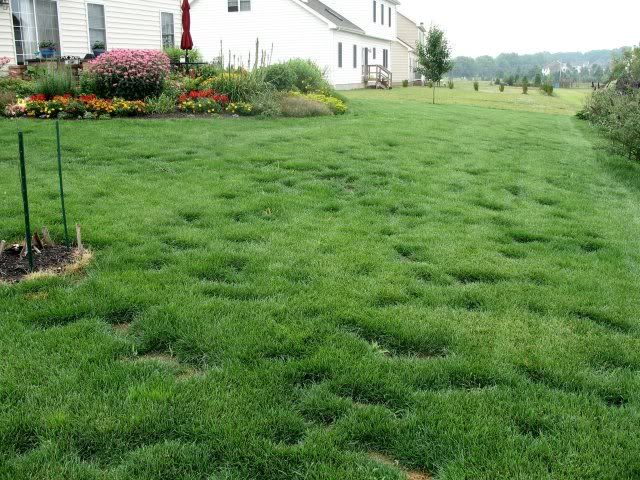 [/caption]
[/caption]
[caption id="" align="alignnone" width="640" caption="August 12, 2008, about 13 weeks"]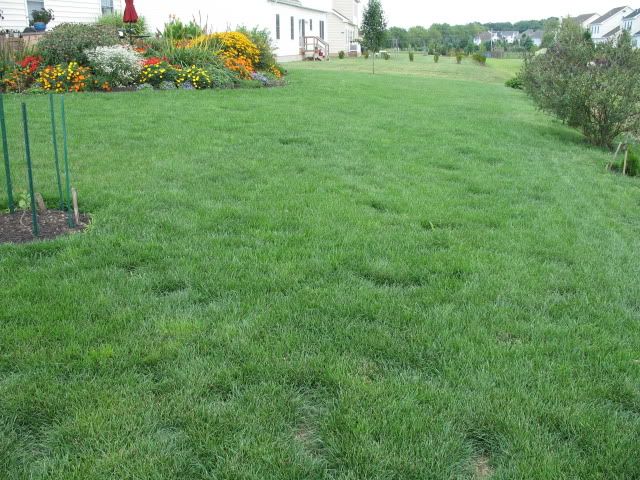 [/caption]
[/caption]
[caption id="" align="alignnone" width="640" caption="September 4, 2008, about 16 weeks--plus a robot"]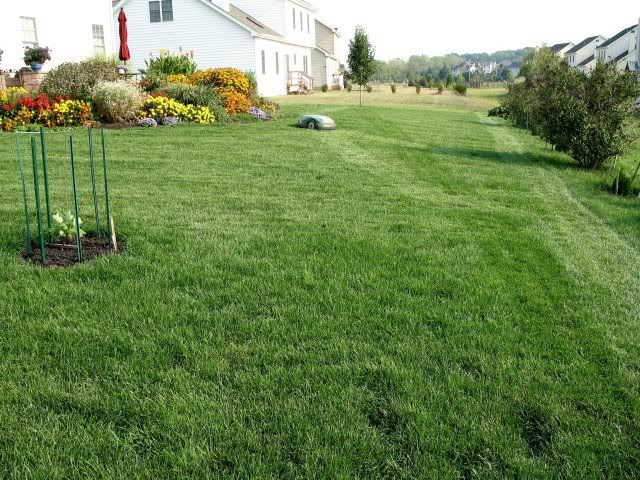 [/caption]
[/caption]
Thursday, April 8, 2010
More April Photos!
This one time I'm posting thumbnails; I don't often post four photos at once. Click on any image to embiggen!
With the weather accelerating right past April and into July, I now have the flowering Cleveland pear trees, hyacinths, tulips, chionodoxa (early white and mid season blue), and just about everything else all blooming at once. And regrettably, not lasting long and not looking very good when it blooms. April blossoms simply can't handle the heat.
Here's a photo of the lawn from this afternoon. It's fully awake, but seems to be wanting a little more iron:
This is the blooming Cleveland pear. The blossoms opened Monday, and it looks like the tree will finish up tomorrow or Friday: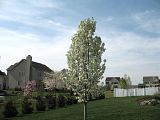
This parrot tulip isn't supposed to bloom until mid-May: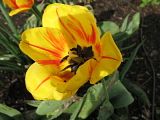
This is an Angelique tulip. They're mid-May bloomers, and generally don't have the slightly brownish color on the flower rib. It's blasting a bit in the heat:
Wednesday, April 7, 2010
Garden Feeding
I'm trying to transform the garden soil to the same standard (or better) than the lawn soil. So I fed again with another 72 pounds of Milorganite, or 36 pounds per thousand, plus added 16 pounds of starter fertilizer to raise the phosphorus level in the soil. The lawn is stabilized at 20 PPM, the gardens should be identical as they received the same treatment. 40 to 60 PPM would be better for gardens where I ask for a great deal of blooming all season long.
So far, that's a grand total of 117 pounds of Milorganite per thousand this year. Although extremely high (and it will be struck with 50 pounds of soybean meal Friday), I'm trying to add as much organic food as possible before I mulch next week.
Friday, April 2, 2010
More Photos!
The lawn is developing quickly this year, although that should be no surprise when temperatures are over 75°. I've included a few bonus photos as well--jonquils, and a purple hyacinth that started to open this morning. Click on any image to embiggen it.
I fed the roses and Thuja with a few handfuls of alfalfa, but I won't bother with the lawn this year. Growth is already excellent and I had to cut it yesterday.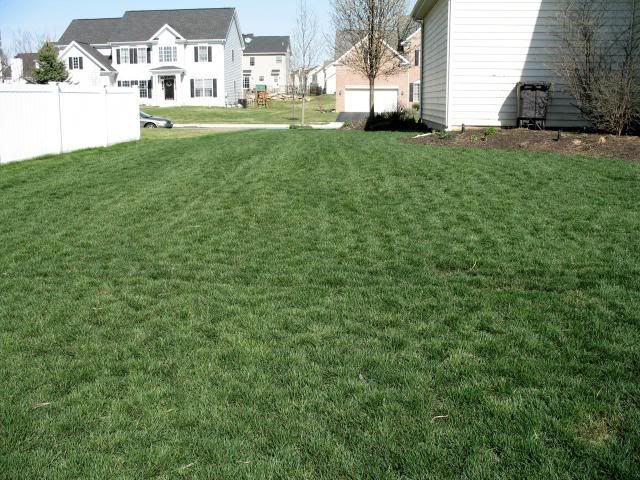
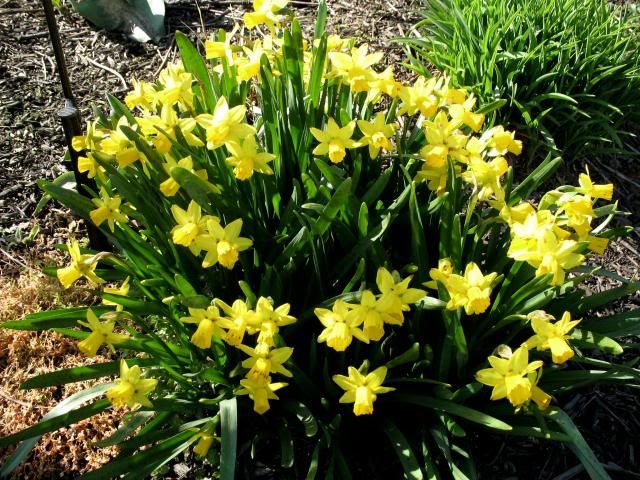

Thursday, April 1, 2010
Feeding the Lawn
Another 108 pounds of Milorganite went down today over the entire 7,000 square feet (for 15.4 pounds per thousand).
This year I'm trying to enhance the gardens as well, so I dropped 36 pounds per thousand through them.
Please note, if you're feeding with synthetics, it's far too early in Pennsylvania to even think about it--wait until mid May for better results.
Wednesday, March 24, 2010
Lighting System Revamp
I spent today rewiring my lighting system a bit--the clips seem to release a lot over the winter, so I clipped the wires and directly wired them to the 12 volt line.
Also, I noted that my entire southern face lighting burns out yearly. Some investigation shows I probably shouldn't have that in the 14 volt tap since it's close to the transformer and not much amperage. Let that be a word to the wise!
Thursday, March 18, 2010
More Photos
Temperatures are holding in the high sixties this week, so development in the grass and gardens has been exceedingly fast. Here's an image from today, post mowing it to remove the dead tips. As always, you can click on any image to embiggen it.
You can see the color's darkened considerably in just a few days, and the grass is already mostly back. Even the new seed is beginning to sprout!
The neighbors' lawns...not so much.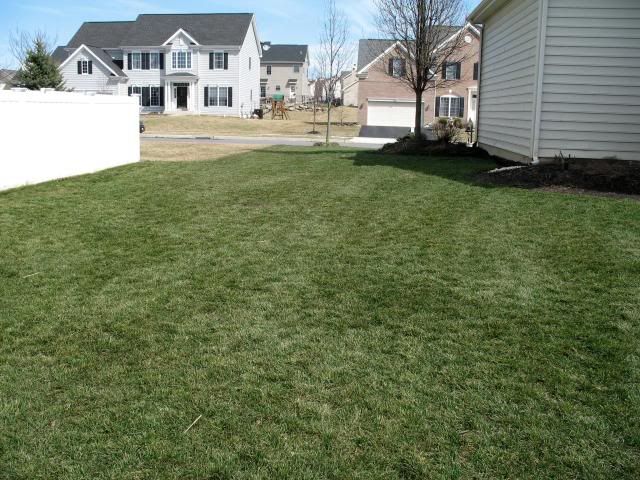
Bonus Shot #1: A blue-blooming Iris Reticulata:
Bonus #2: Purple crocuses!
Tuesday, March 16, 2010
First Mow
I just put the Robomower out for the first mow to remove the dead tips from the grass and expose the greener mat underneath. Temperatures will be sixty or above for the rest of the week, so getting some sunlight down to the soil will help wake it up. Not that it needs much help, the green edge is already spreading out from the curb and the gardens. At this rate, by Friday the lawn will be back for the year, a month earlier than last year.
In other gardening news, I have plenty of blooming crocuses. I'll have to take a photo later.
Wednesday, March 10, 2010
Soil Samples Taken
I took my soil samples today for UMass Amherst soil testing. I'll be getting Test C, the standard soil test with organic matter. I had also gotten test E last year, soluble salts, but I don't expect that to have changed since I don't use synthetic fertilizers.
The soil difference over the last year is pretty amazing. There are very few remaining "sticky bits" of clay, and what remains crumbles pretty easily. I even disturbed a few early worms! Since half a ton of organic matter per thousand square feet went down on the lawn last year (much of that being chopped leaves), I would have expected some change. This was a bit surprising, however.
The drying soil is fairly dark, so I'm hopeful that my organic matter tests will come back with good scores this year. Last year I was at 4.6%, or tolerable but a bit low.
Saturday, March 6, 2010
Let The Games Begin!
They're beginning a month later than last year, but we had some snow this year. Additionally, the lawn probably doesn't need the organic material any longer (not after last year's addition of more than half a ton per thousand square feet). I'll take my soil samples for U. Mass Amherst shortly.
I've cleaned the gardens to fully open them up for the sprouting bulbs. The crocus should be blooming shortly, barring a sudden reverse in the weather. The back burlap line is down, and I lightly frost-seeded the entire lawn with the mix I chose for the damaged front area.
I added 90 pounds of Milorganite (12.8 pounds per thousand) today as well, for 0.64 pounds of nitrogen, 0.26 pounds of phosphorus, and 0.51 pounds of iron. That will activate over the next few weeks.
Monday, March 1, 2010
March Lawn Photo
The last blizzard is melting away nicely, and the grass is being exposed. Here's a photo, plus a bonus--the gardens are beginning to sprout. If you look closely, you'll see the earliest of the jonquils and crocuses. Here and there I have an early tulip sprouting as well.

Tuesday, February 2, 2010
February Lawn Photo
I took this one yesterday before the snow but after the extended cold period we had. The lawn is definitely in winter mode at this point and will stay there for a month or so. On the up side, this is the shortest winter period the lawn has shown (and the weather is pretty average this year), and even so, it's greener than last year at this time!
Tuesday, January 19, 2010
Winter Seeding
I winter-seeded the bad areas of the lawn (mostly the front area where the Township damaged the grass in October and November). There were a few small holes from Poa annua incursions as well.
Winter-seeding involves dropping normal levels of seed, preferably just before some winter weather (although that's not required). We're slated for some snow tomorrow into Friday, possibly. The new seed will sprout as soon as it can, usually around April 10th or so here, and it then has about 2 1/2 months to prepare for summer.
I split my winter seeding into three parts. Part one was dropped back in late November when temperatures became cold enough that the seed wouldn't sprout. Part two was today. Part three, if I can do it, will be in mid to late February. However, one winter seeding sometime during the season would be just fine, and it can be done atop the snow if necessary.
The lawn isn't looking bad for January. For the most part, it looks the same as in December, except a bit paler. Winter color this year is excellent and temperatures have been normal. First feeding isn't slated until March of this year, but that will depend on the weather.
